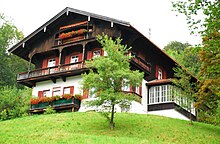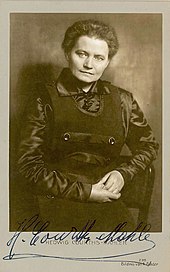Hedwig Courths-Mahler
Hedwig Courths-Mahler (born February 18, 1867 in Nebra , † November 26, 1950 in Tegernsee ; actually Ernestine Friederike Elisabeth née Mahler ) was a German writer . She wrote over 200 romance novels , which were very popular during her lifetime, are still available in abbreviated form as regular booklet novels up to the present day , and which made her probably the most successful German novelist based on the number of copies sold.
Life

Ernestine Mahler was born out of wedlock to the sutler Henriette Mahler and the Saaleschiffers Ernst Schmidt. Her father died in Königgrätz in 1866 before she was born . Her stepfather Max Brand refused her, which is why the half-orphan grew up with the shoemaker couple Birkner in Weißenfels . She dropped out of school early to earn some money.
At the age of 14 she came to Leipzig to see her mother, who is now living here. She now worked as a maid and at the same time as a reader for an old lady in her employer's family. Through this and through reading Marlitt novels in the " Gartenlaube " to which this family subscribed , she came into contact with literature and discovered her joy in writing. At the age of seventeen she wrote her first short story Where the Heath Blooms , which was published in a local newspaper. She then worked as a saleswoman in Halle .
In 1889 she married the decorative painter Fritz Courths in Leipzig and had two daughters. After her husband took a job in Chemnitz in 1894 , the whole family moved there. She continued to write, and in 1904 her first novel Licht und Schatten appeared in sequels in the Chemnitzer Tageblatt , now under the name Hedwig Courths-Mahler.
In 1905 the family moved to Berlin because Fritz Courths' employing company had moved to Berlin. From 1905 to 1914 she lived in Karlshorst in the house of Fritz Courths' brother, the architect F. Courths, and then in Charlottenburg . An intense creative period began for Hedwig Courths-Mahler in Berlin. The covers of her novels, several of which appeared annually, fourteen in 1920 alone, were mostly designed by her husband. Hedwig Courths-Mahler became one of the most respected personalities in Berlin. Numerous Berlin artists, especially actors, including Adele Sandrock , Emil Jannings , Curt Goetz , Fritzi Massary and Käthe Haack , frequented her salon in Charlottenburg .

In 1935 she bought a house in Tegernsee with a view of the lake and the Wallberg , which her daughter Margarete named "Mutterhof" and into which the entire family with daughters and sons-in-law moved. Her husband died in 1936.
During the National Socialist dictatorship Hedwig Courths-Mahler belonged like all professional writers to the Reichsschrifttumskammer . She was also a supporting member of the SS (membership number 916 398). Since she refused to adapt her novels to the requirements of the Nazi regime, there were hardly any new editions from 1935 onwards. In 1941/42 only five of her works were still available. She later tried to be released from the Chamber of Literature, but her request was refused because "the works of the Courths-Mahler are still being sold".
Her daughters Margarete Elzer (1889–1966) and Elfriede Stein (1891–1985, pseudonym Friede Birkner ) were also successful writers. They too got into political difficulties. Friede Birkner was banned from writing in 1941 and was sentenced to 28 months imprisonment and forced labor under the Treachery Act. Margarete Elzer, who initially celebrated success with trivial novels during the Nazi era, was expelled from the Reich Chamber of Literature in 1941.
As Courths Mahler died at her home in Tegernsee in 1950, she had (also under the pseudonyms Relham and Hedwig fire 208 entertainment novels and) total - novellen published, which have been translated into numerous languages and a total circulation of estimated reached 80 million copies. Over 20 books have been filmed. She was buried in the Egern cemetery.
Works
Hedwig Courths-Mahler's works generally follow the same pattern: socially disadvantaged people overcome class differences through love. The lovers fight against all kinds of intrigues and finally find each other, gain wealth and prestige. Despite the constant criticism of the clichés in her work and the conservative views of the author from today's perspective on male-female role behavior , her books still find a broad readership, especially women.
- The Wild Ursula (1912)
- The Begging Princess (1914)
- I want (1916)
- Unfaithful (1916)
- Griseldis (1917)
- My Käthe (1917)
- The Assmanns (1918)
- An Unloved Woman (1918)
- The beautiful unknown (1918)
- Red Roses (1919)
- The mock meal (1919)
- The Silent Sorrow (1919)
- Magdala's Sacrifice (1929)
- What God Put Together (Year Unknown)
- Escape from Marriage (1934)
- If wishes could kill (year unknown)
- The mistress of Retzbach (year unknown)
- The Unequal Sisters (1931)
- In the beech ground
In addition to the novels published as books, a number of novels were also published in the form of a series of booklets in the Bastei publishing house and after the series ran out they were reprinted at irregular intervals. There is a library of her novels in the historical collections of the Berlin Central and Regional Library Foundation .
reception
Courths-Mahler was already a controversial figure during his lifetime, like Hans Reimann's parody “Hedwig Courths-Mahler. Simple stories for your home sweet home. Adorned with lovely pictures by George Grosz ”, which appeared in 1922, makes clear. She told stories of orphans with blond hair who were saved by handsome counts, of poisonous comtesses and loyal soldiers' brides . In the 1960s, her novel motifs were used in the RIAS series Back then - Stories from Old Berlin . With the support of Bastei Lübbe Verlag , the Hedwig Courths-Mahler Circle of Friends set up the Hedwig-Courths-Mahler Archive in Nebra in 1991 .
Film adaptations
In the 1970s, five novels were filmed by Süddeutscher Rundfunk (SDR) and broadcast with great success. Gert Westphal narrated the plot in an ironic way , while the main roles were occupied by prominent actresses (e.g. Sabine Sinjen ) and actors.
|
|
exhibition
On the occasion of Courths-Mahler's 150th birthday , an exhibition was held in the Lichtenberg Museum in the Berlin district of Lichtenberg from February 17, 2017 to April 2, 2017. The exhibition was entitled Fairy Tales of a Better Life and traced the writer's career on picture and text panels.
literature
- Régine Atzenhoffer: Ecrire l'amour kitsch. Approches narratologiques de l'oeuvre romanesque de Hedwig Courths-Mahler (1867–1950) (= Contacts. Sér. 3: Etudes et documents. Vol. 65). Lang, Bern 2005, ISBN 3-03910-341-5 .
- Lia Avé : The Life of Hedwig Courths-Mahler. Drei-Ulmen, Munich a. a. 1990, ISBN 3-926087-09-9 .
- Andreas Graf: Hedwig Courths-Mahler , dtv Verlagsgesellschaft , Munich 2000, ISBN 3-423-31035-9 .
- Walter Kunze: Courths-Mahler, Hedwig. In: New German Biography (NDB). Volume 3, Duncker & Humblot, Berlin 1957, ISBN 3-428-00184-2 , p. 383 f. ( Digitized version ).
- Thomas Küpper: The kitsch of society? Systems-theoretical observations of the popular using the example of Hedwig Courts-Mahler . In: Jessica Nitsche, Nadine Werner (eds.): Popular culture, mass media, avant-garde 1919–1933 , Wilhelm Fink, Munich 2012, pp. 37–52. ISBN 978-3-7705-5278-8
- Ingrid Müller: Investigations into the image of women in the novels by Hedwig Courths-Mahler (= Bielefelder Hochschulschriften. Vol. 16). Pfeffer, Bielefeld 1978, ISBN 3-88024-018-3 .
- Gunnar Müller-Waldeck : The "great realist". Hedwig Courths-Mahler or the truth of fairy tales. In: New German Literature . Vol. 535, 2001, pp. 140-155. With the reply from Sigrid Töpelmann: Escape to peace. In: ibid., Vol. 538, 2001, pp. 142–152.
- Eva Ochs: gentlemen and full natures. The male ideal in Hedwig-Courths-Mahler's novels. Fernuniversität, Hagen 2004.
- Siegfried M. Pistorius: Hedwig Courths-Mahler. Your life (general series vol. 11832). Bastei-Lübbe, Bergisch Gladbach 1992, ISBN 3-404-11832-4 .
- Curt Riess : No dream remained unfulfilled. The fairytale ascent of Hedwig Courths-Mahler. Lichtenberg, Munich 1974, ISBN 3-7852-1163-5 .
- Hans Sarkowicz , Alf Mentzer: Literature in Nazi Germany . Europa, Hamburg 2002, ISBN 3-203-82030-7 , p. 138.
- Friede Birkner: Our mother Hedwig Courths-Mahler. Experienced, told, remembered. Edited by Gunnar Müller-Waldeck , Anhalt Edition Dessau, Dessau-Roßlau 2017. ISBN 978-3-936383-28-7 .
Web links
- Literature by and about Hedwig Courths-Mahler in the catalog of the German National Library
- Works by and about Hedwig Courths-Mahler in the German Digital Library
- Hedwig Courths-Mahler in the Bavarian literature portal (project of the Bavarian State Library )
- Hedwig Courths-Mahler. Tabular curriculum vitae in the LeMO ( DHM and HdG )
- The Hedwig-Courths-Mahler collection is located in the historical collections of the Central and State Library Berlin Foundation .
- Portrait of the author Hedwig Courths-Mahler at Bastei-Verlag
- Life, work, films, archive on the private website Hedwig-Courths-Mahler.de
Individual evidence
- ↑ A weekly issue from Bastei-Verlag
- ↑ Ben Witter : Celebrity portraits . Fischer Taschenbuch-Verlag, Frankfurt / Main 1977. p. 33.
- ↑ Dönhoffstrasse 11 . In: Berliner Adreßbuch , 1911, part 5, Karlshorst, p. 234.
- ↑ Courths-Mahler, Hedwig . In: Berliner Adreßbuch , 1917, part 1, p. 415.
- ↑ The "witch's house" on the mountain. In: Tegernsee voice. April 6, 2015, accessed November 24, 2018 .
- ↑ Martin Wolf: Tears of Disgust . In: Der Spiegel . No. 47 , 2000 ( online ).
- ^ Christian Adam : Reading under Hitler: authors, bestsellers, readers in the Third Reich. Galliani, Berlin 2010, p. 200.
- ↑ Ben Witter: Celebrity portraits , p. 34.
- ^ Andreas Graf: Hedwig Courths-Mahler , 2000, pp. 7–9.
- ^ DIF - Deutsches Filminstitut, Frankfurt am Main, Prüf. card no.7402
- ↑ Hedwig Courths-Mahler - The Queen of the Kitsch novel, SWR 2 2017
- ↑ Friends of Hedwig Courths-Mahler ( Memento of the original from October 31, 2010 in the Internet Archive ) Info: The archive link has been inserted automatically and has not yet been checked. Please check the original and archive link according to the instructions and then remove this notice.
- ^ Website Museum Lichtenberg
| personal data | |
|---|---|
| SURNAME | Courths-Mahler, Hedwig |
| ALTERNATIVE NAMES | Mahler, Hedwig; Courths-Mahler, Ernestine Friederike Elisabeth (full name); Brand, Hedwig (pseudonym); Relham (pseudonym) |
| SHORT DESCRIPTION | German writer |
| DATE OF BIRTH | February 18, 1867 |
| PLACE OF BIRTH | Nebra , Province of Saxony, German Empire |
| DATE OF DEATH | November 26, 1950 |
| Place of death | Tegernsee , Bavaria, Germany |

